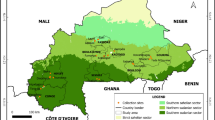Abstract
Adaptive and wood quality trait data were collected and analyzed on commercially available Juglans regia and J. regia×J. nigra provenances and progenies planted across Europe in a multi-site network. A total of 19 seed sources, replicated 35 times per site, were planted at 13 sites from 5 European countries, encompassing the potential distribution area of timber production plantation sites. The following traits were evaluated: survival, height, diameter at breast height, stem form, apical dominance, vegetative budbreak, along with biotic and abiotic damage. Mean values were significantly different both among provenances/progenies and sites. Most common damage was late spring and early autumn frost. Bud break ranking was significantly correlated with provenance and progeny origin. Although J. regia is fast growing, southern European early budbreak plant material should not be planted under most middle European conditions where late spring frost can be expected, as it has a significant negative impact on architectural (and thus wood quality) traits. Hybrid J. regia×J. nigra progeny performed better than J. regia provenances/progenies for most traits measured. Differences were significantly in favor of hybrids at sites with medium to low fertility, although some locally selected seed sources tended to perform as well as hybrids on high fertility sites.
Similar content being viewed by others
References
Becquey J. 1990a. Où peut on planter des noyers? Quelques principes de base. Forêt Entreprise 72: 15–16.
Becquey J. 1990b. Quel noyer choisir? Les facteurs déterminants. Forêt Entreprise 72: 17–19.
Becquey J. 1994. Synthèse des travaux, groupe D. Third report, contract AIR3-CT92-0142. European development of walnut for wood and fruit production as an alternative extensive system to agricultural crops. 11 pp.
Beineke W.F. 1983. The genetic improvement of black walnut for timber production. In: Janick J. (ed.), Plant Breeding Reviews Vol. I. AVI Publishing Co. Inc., Westport Conn., USA, pp. 236–266.
Bresnan D.F., Rink G., Diebel K.E. and Geyer W.A. 1994. Black walnut provenance performance in seven 22-year-old plantations. Silvae Genetica 43: 246–252.
De Martonne E. 1926. L'indice d'aridité. Bull. Assoc. Géog. Fr 9: 3–5.
Fornari B., Cannata F., Spada M. and Malvolti M.E. 1999. Allozyme analysis of genetic diversity and differentiation in European and Asiatic walnut (Juglans regia L.) populations. Forest Genetics 6: 115–127.
Germain E. 1992. Le noyer. In: Gallais A. and Bannerot H. (eds), Amélioration des espèces végétales cultivées, objectifs t critères de sélection. INRA éditions, Paris, France, pp. 620–632.
Germain E. and Fady B. 1998. Juglans et hybrides interspécifiques – noyer. In: Arbez M. and Lacaze J.F. (eds), ≪ Les ressources génétiques forestières en France. Tome 2: les feuillus ≫. BRG and INRA éditions, Paris, pp. 109–136.
Germain E., Prunet J.P. and Garcin A. 1999. Le noyer. CTIFL, Paris, 279 p.
Jay-Allemand C., Fady B. and Becquey J. 1996. Walnut trees for woodland use in Mediterranean countries: current situation and prospects. Nucis 5: 10–13.
Mauget J-C. 1987. Dormance des bourgeons chez les arbres frutiers de climat tempéré. In: Le Guyader H. (ed.), Le dévéloppement des végétaux, aspects théoriques et synthétiques. Masson, Paris, pp. 133–150.
Mauget J-C. 1983. Etude de la levée de dormance et du débourrement des bourgeons de noyer (Juglans regia L., cv. “Franquette”) soumis à des températures supérieures à 15 oC au cours de leur période de repos apparent. Agronomie 3: 745–750.
Rink G. 1984. Trends in genetic control of juvenile black walnut height growth. For. Sci. 30: 821–827.
Rink G. and Clausen K.E. 1989. Site and age effects on genotypic control of juvenile Juglans nigra L. tree height. Silvae Genetica 38: 17–21.
Steiner K.C. 1979. Patterns of variation in bud burst timing among populations in several Pinus species. Silvae Genetica 28: 185–194.
Williams R.D., Rink G. and Funk D.T. 1985. Planting site and genotype affect black walnut seedling development more than nursery environment. Can. J. For. Res. 15: 14–17.
Author information
Authors and Affiliations
Corresponding author
Rights and permissions
About this article
Cite this article
Fady, B., Ducci, F., Aleta, N. et al. Walnut demonstrates strong genetic variability for adaptive and wood quality traits in a network of juvenile field tests across Europe. New Forests 25, 211–225 (2003). https://doi.org/10.1023/A:1022939609548
Issue Date:
DOI: https://doi.org/10.1023/A:1022939609548




